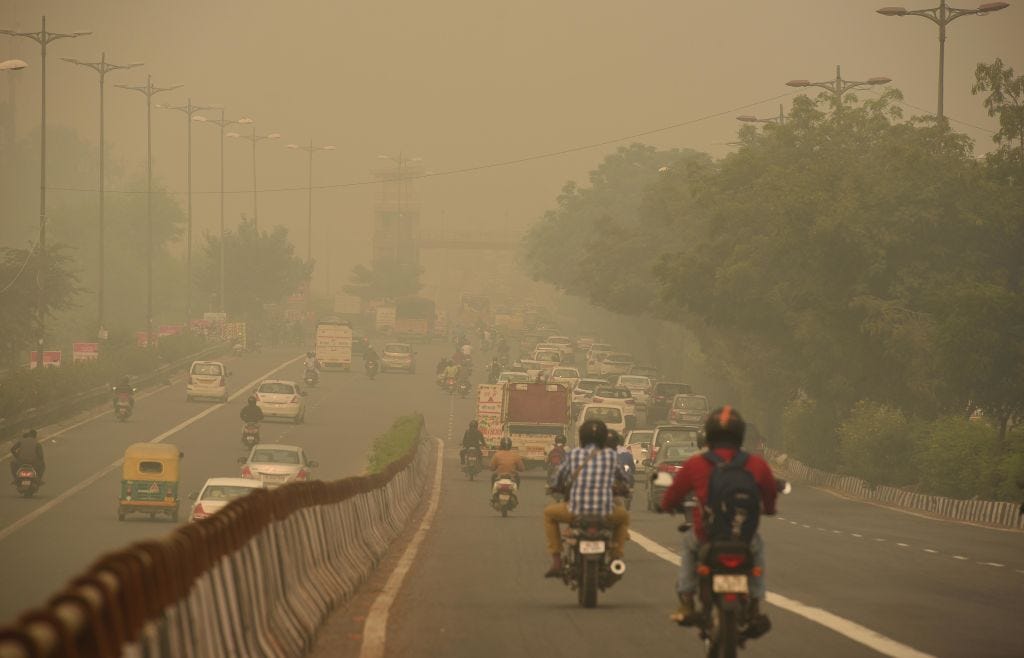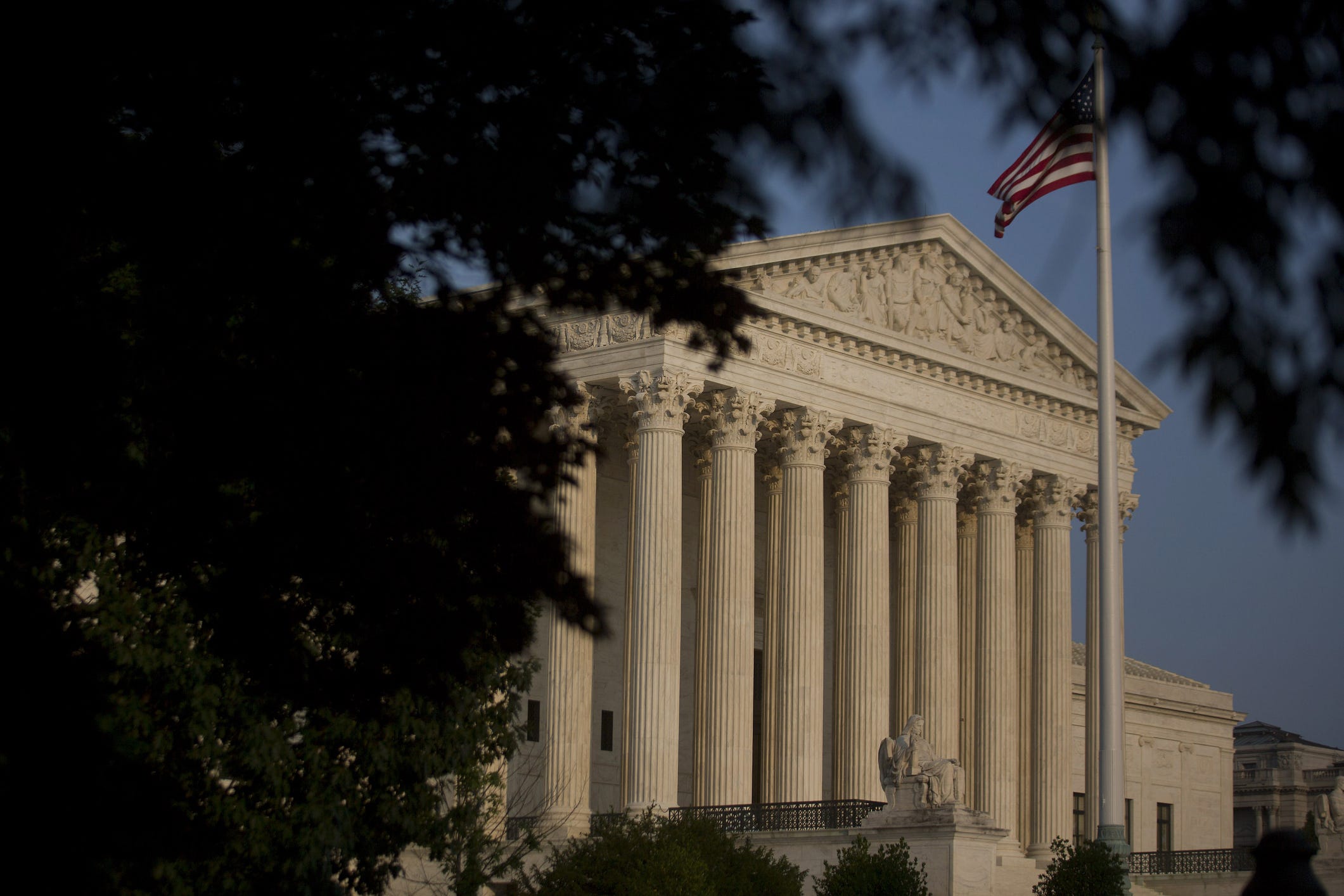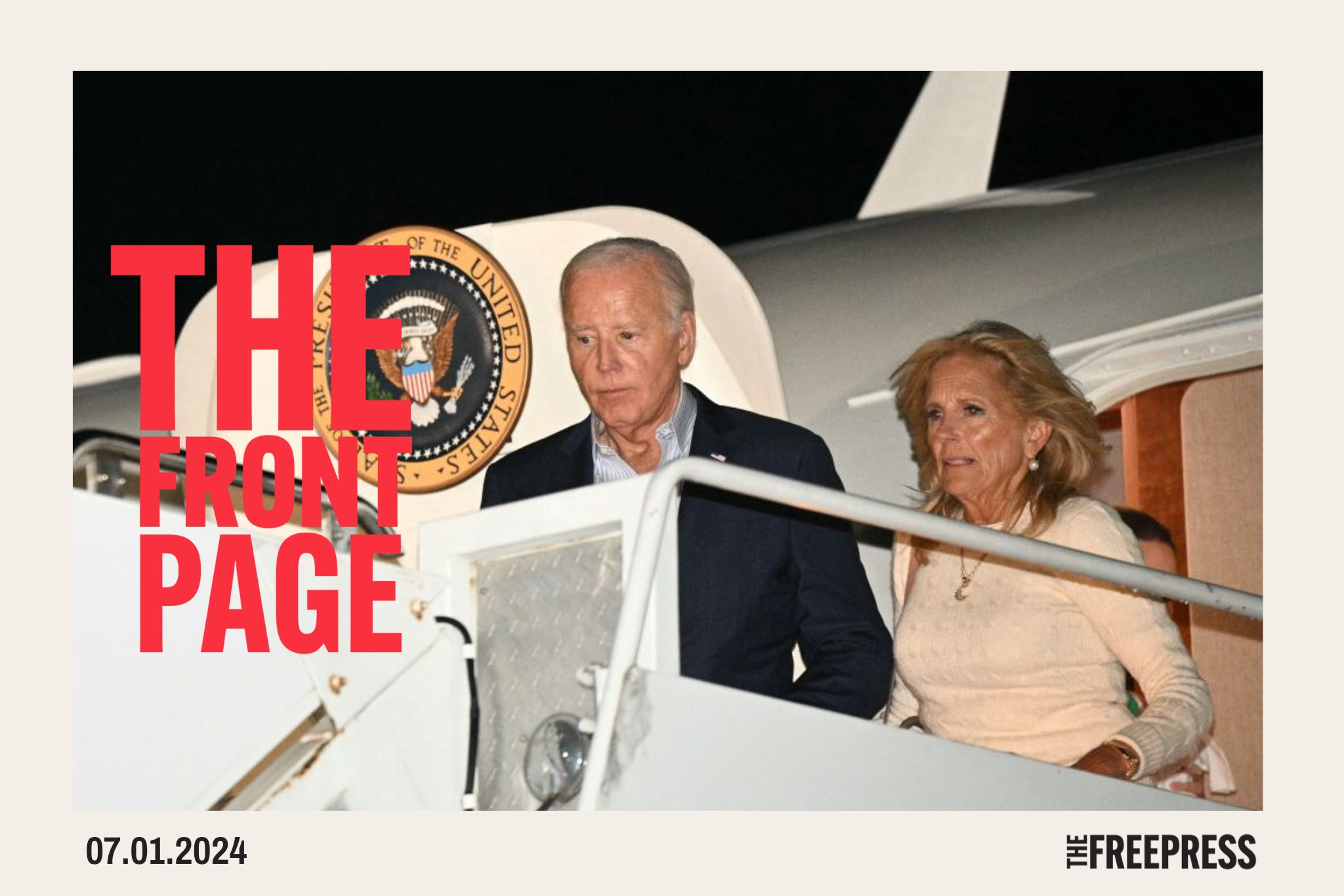Substacks
Can Pollution Save the Planet? Rupa Subramanya

During the first months of the pandemic, in the spring of 2020, India’s government imposed one of the most draconian lockdowns anywhere in the democratic world. I happened to be in Mumbai at that time, where you couldn’t go more than half a mile from your home except for essential purposes. Unpleasant as this was, there was one positive side effect: the notoriously polluted skies of Mumbai—like those of other big Indian cities, from Delhi to Bangalore—suddenly became much clearer. With far fewer cars on the road, factories shut, and flights grounded, the amount of aerosols in the atmosphere fell to their lowest rate in 20 years.
Then came the negative side effect. That summer, India experienced some of the hottest temperatures ever recorded. Globally, the year 2020 was one of the warmest on record; the average temperature in India that year was 0.29 Celsius degrees hotter (roughly 0.52 degrees Fahrenheit) than during 1981–2010.
This is no coincidence. It is well known that aerosols make clouds bigger, brighter, and more reflective; when they decrease, more sunlight reaches the earth, which leads to higher temperatures. And a 2023 study showed how, during the pandemic, clearer skies across South Asia increased climate warming.
As we clean up the environment, we must be conscious of this trade-off. I was reminded of my lockdown in India a few weeks ago, when it was reported that an attempt to cleanse one of the world’s most polluting industries has, unfortunately, exacerbated global warming.
In January 2020, new shipping regulations were put in place by the International Maritime Organization, to reduce the permissible sulfur content of shipping fuel from 3.5 percent to 0.5. The intended effect was to reduce the sulfur dioxide emitted by maritime vessels by about 80 percent; the actual reduction was about 70 percent. The IMO’s expectation was that this would lead to “reductions in stroke, asthma, lung cancer, cardiovascular and pulmonary diseases.”
“Cutting sulphur emissions from ships will also help prevent acid rain and ocean acidification, benefitting crops, forests, and aquatic species.”
But according to a study released last month, the “abrupt reduction in shipping emission” had an unintended consequence. Sulfur dioxide has a powerful cooling effect on the planet, because it reacts with water vapor to produce aerosols, which help block the sun.
Led by Tianle Yuan, a scientist at the University of Maryland and NASA, this latest study therefore found that cutting emissions from shipping could warm the atmosphere by 0.16 degrees Celsius within a decade. (Aerosols vanish quickly from the atmosphere.) The 2020s are expected to be “anomalously warm”—and we already know that the year 2023 was the hottest on record.
“There is a trade-off between reducing aerosol pollution and additional warming,” Yuan told me. The well-known climate scientist James Hansen refers to this trade-off as a “Faustian bargain.”
“In terms of policy,” Yuan added, “we need a better understanding of the pros and cons of the impact on human health and climate/environment.” It is far more difficult to quantify the health benefits from the reduction of aerosols than it is to measure the additional global warming.
Yuan’s findings have been challenged, notably by Zeke Hausfather, a climate scientist at the Breakthrough Institute. “Yuan and colleagues are not too far off on the ultimate amount of warming that will result from the regulations,” he told me. “They just assume it will happen nearly immediately rather than over the course of decades as the ocean heats up.”
Importantly, he isn’t challenging the magnitude of warming that Yuan predicts as a result of these shipping regulations, but rather how quickly the warming will come about.
“More sophisticated models give a much smaller effect (0.05° C to 0.07° C or so) in 2023 than the 0.16° C they suggest in the paper,” he said.
There are other effects of reducing aerosols in the atmosphere. If you live in North America, you’ve probably noticed an uptick in wildfires in recent years. A recent study from the University of California, Riverside finds that reducing aerosols may increase wildfires—even more than a rise in greenhouse gases—because, it is thought, aerosols dry out plants more than greenhouse gases do, making them more flammable.
So, does all this mean we shouldn’t stop polluting? Is there some sense in which pollution is “good”? Should we actually inject aerosols into the atmosphere to slow down global warming—as some have suggested?
No, we shouldn’t go that far. Yangyang Xu, a professor of atmospheric sciences at Texas A&M University, told me: “The health benefits of cutting air pollution outweigh the negative impact of accelerating global warming.
“There is no basis for continuing polluting the air for the sake of ‘masking’ some global warming.”
This is especially true, he added, in heavily polluted countries such as China and India, where there is considerable loss of life every year due to respiratory illnesses.
The general consensus in the scientific community is that if we focus on reducing aerosols without also reducing greenhouse gases, global warming will only accelerate, so we need to channel our resources into eliminating both simultaneously. But when it comes to environmental concerns, aerosols may be a lesser evil—one that might even buy us time until we work out how to get other emissions under control.
Rupa Subramanya is a reporter for The Free Press. Follow her on X @rupasubramanya and read her piece “Stop Making Plane Turbulence About Climate Change.”
To support The Free Press, become a Free Press subscriber today:
Substacks
Craig Murray’s Campaign Against Empire Chris Hedges

Craig Murray – by Mr. Fish
Blackburn, England: I am standing with Craig Murray who is running for Parliament in this gritty former mill town. We are on a narrow street with brick row houses that jaggedly descend down a hill. The sky is overcast. There is intermittent rain.
Craig, portly, his white hair unkempt and dressed in a clashing checkered shirt with a paisley tie, is handing out leaflets at the entrance of the Masjid e Tauheedul Islam, Blackburn’s largest mosque. He introduces himself politely to those leaving the midday prayers.
I speak with about half a dozen of the worshippers, who like most of the Muslim community in Blackburn, are of Indian and Pakistani origin. They curtly dismiss the leaders of the ruling Labour and Conservative parties as out of touch with their lives and concerns, including their outrage over the genocide in Gaza.
Craig’s central campaign issue, like that of George Galloway — who was recently elected as MP for Rochdale — is ending the genocide in Gaza, including the halting of all arms shipments to Israel. Craig is running on the ticket of Galloway’s socialist Workers Party of Britain, to counter what he says is the “appalling pro-genocide stance” of the opposition Labour Party, which looks set to win the British elections on July 4, ousting the Conservative Party government led by Prime Minister Rishi Sunak.
The Labour Party has won the parliamentary elections in Blackburn for the last 69 years. The socialist crusader, Barbara Castle — instrumental in exposing the British atrocities in Kenya, including the deaths of perhaps 300,000 Kikuyu people and the detention of up to 320,000 more in over 100 camps, where prisoners were tortured, murdered and died of disease — previously held this seat, as did the former foreign secretary Jack Straw. Straw was decidedly less progressive. He was one of the architects of the 2003 war in Iraq under former prime minister Tony Blair. Craig challenged Straw for the seat in 2005 on an anti-war platform. He received five percent of the vote.
The Labour MP for Blackburn, Kate Hollern, in the last election in 2019, won 64.9 percent of the vote. She deviates from the Labour Party line on Gaza, calling for an immediate ceasefire and a suspension of arms shipments to Israel. She was one of the few party members who remained loyal to Jeremy Corbyn when his campaign to run for prime minister was sabotaged by party apparatchiks close to Blair, who accused him of being an anti-Semite because of his defense of Palestinians.
“I have nothing bad to say about the woman really, except that if elected, she would be part of putting Keir Starmer into Number 10 and I have a very great deal against Keir Starmer,” Craig says of his Labour opponent.
Straw, although out of Parliament, casts an ominous shadow over Craig’s campaign. For, as in most of the constituencies where Labour is being challenged by candidates that oppose Labour’s support for Israel, a second well-funded independent, devoid of political experience or a public record on nearly all issues, is also running on an anti-genocide platform. In the case of Blackburn, this person is Adnan Hussain. While Hussain spends much of his campaign attacking Craig, Craig has held a series of meetings on Palestine, including one where he, Richard Medhurst and I spoke to a packed hall at Saint Paul’s Methodist church in Blackburn. Craig has also hosted campaign events with Professor David Miller, who was fired in 2021 from the University of Bristol for his criticisms of Israel, and Dr. Bob Gill, who has documented the defunding, outsourcing and marketization of Britain’s National Health Service by all ruling parties since Margaret Thatcher. Roger Waters is scheduled to hold a campaign rally in Blackburn for Craig on July 2.
The Muslim media site, 5Pillars, proposed that Craig and Hussain toss a coin to see who should run as an independent against the Labour Party. Craig agreed. Hussain, a 34-year-old lawyer, refused.
“The people behind Hussain’s campaign are Jack Straw’s people,” Craig says. “The people financing and organizing his campaign are Jack Straw’s people. The Labour Party is splitting the challenge. It’s not only here. It’s happening around the country.”
Craig’s cluttered second floor campaign office sits on a narrow street above the Mi Chaii cafe on Whalley Range. Covering the windows outside are huge posters and billboards with pictures of public figures, including George Galloway, Roger Waters and Stella Assange, with their brief endorsements supporting Craig’s candidacy.
Nearly half of Blackburn’s constituents are Muslim. The town is reputed to have more mosques than any town in Europe. British Muslims, like Muslims in the U.S. who have abandoned Joe Biden, have walked away from the Labour Party because of Starmer’s unequivocal support for Israel. In Blackburn’s local council elections in May, Labour suffered a significant decline in votes.
Craig, the former ambassador to Uzbekistan, was pushed out of the Foreign Office after leaking to The Financial Times, in 2004, a memorandum he authored that detailed the CIA torture and extraordinary rendition program in Uzbekistan. Craig says his internal protests to the Foreign Office were ignored.
He exposed practices in Uzbek black sites of sexual humiliation, genital mutilation, the rape of men and women, cutting and the dousing of prisoners with boiling liquid, including the death of a prisoner who was immersed in a vat of boiling water.
“The Uzbeks were doing it on behalf of the CIA,” he tells me one morning as we sit in his campaign office. “At first, the prisoners were mostly Uzbeks who had been captured in Afghanistan. But latterly, people were being brought in from all over the place.”
According to the Council of Europe report on extraordinary rendition, of all the CIA flights that stopped in Poland, 50 percent went to Uzbekistan.
Straw, at the time of Craig’s revelations, was the foreign secretary. He pushed for Craig’s prosecution, something the Foreign Office decided against. Caught in a “cash for access” sting, Straw was forced to retire from politics. But he remains a powerbroker in the Labour Party, especially in Blackburn.
“This is entirely prompted by the genocide in Gaza,” Craig says of his parliamentary campaign. “I wouldn’t have come back were it not for the genocide in Gaza. Starmer’s attitude to the genocide in Gaza reminds me of Straw’s attitude to torture, extraordinary rendition and the Iraq war. The Labour Party is corrupt. It doesn’t stand for any of the principles the Labour Party is supposed to stand for.”
“Gaza represents the dislocation of the political class from the people,” he says. “The people want to stop it, certainly here in the U.K., but they have no leverage. The political class is no longer connected to the people. It is connected to the arms industry, to the lobbyists, particularly the Zionist lobby. That’s where the interests of the political class lie. They don’t care about the people. That’s true of both of the main parties. They suffer no hardship because there’s nobody else likely to be elected. Western democracy has become meaningless. The political class is homogeneous. All of them could move from one of the main parties to the other main party without changing anything. If we’re going to save democracy, we have to offer an actual democratic alternative. Gaza brought that home to people.”
Craig, an ardent supporter of Julian Assange, who produced the most erudite reporting on Julian’s many court hearings, spent four months in prison in Edinburgh in the summer of 2022.
He was found in media contempt of court for his reporting on the trial of the Scottish independence leader Alex Salmond, who was accused of sexual assault.
“It was another example of the state using sexual allegations to undermine and wreck the reputation of an opponent,” he says of Salmond and Julian.
The group of women who brought the charges against Salmond were closely connected to the then first minister, Nicola Sturgeon. It included her chief of staff. Craig was jailed for hinting at this fact in his court reports.
Salmond was found not guilty.
“Over 5,000 individuals wrote to me in jail,” he says. “I answered all those by hand, 50 or 60 letters a day.”
“There were quite a lot of illiterate prisoners,” he says. “If you want anything in jail you have to fill in a form. If you cut your foot and need a sticking plaster, you have to fill a form. If you want a family visit you have to fill in a form. Forms would appear under my cell door. Someone would shout through the door what they wanted filled in. A majority of prisoners are there because of poverty. Their crime is poverty. They’ve all been born into deprivation. They’ve had a very poor education. Most of them were born into addiction. The number who are not addicts is tiny. On my entire block, which would be 120 people, there were two people who weren’t addicts and one of them was me.”
“Most of them are in jail for very, very petty crimes,” he continues. “They shoplift or burgle or deal small amounts of drugs in order to feed their addiction. And then they get put in jail. They get no treatment for addiction in jail. They get prescribed drugs daily because the guards want to keep them dazed. Every morning they get their fix. They serve two years. They’re released back out again. They go and burgle someone else and get caught and then they’re back in again. Most of them have been in jail five or six times. The number of real criminals, as in violent people or people who have done large scale crime, is tiny. Most of them are very, very sad, incapable people who need help with their lives. They don’t need locking up.”
“I hadn’t realized so many people have abject, bleak lives, lives without hope,” he says softly. “Their whole life has been without hope from the day they were born. They never had a chance, never had direction. I thought I was socially aware. I realized I’m not. I didn’t know what it was like at the bottom of society.”
“The state has a monopoly on violence and uses it,” he says. “It used extreme violence against Julian Assange, which had a deleterious effect on his health, both mental and physical.”
On October 16, 2023, as he was returning from a WikiLeaks meeting in Reykjavik, where he also attended a pro-Palestine demonstration, Craig was detained and interrogated in Glasgow airport under Schedule 7 of the Terrorism Act 2000. He was questioned about his relationship with WikiLeaks and his support for the Palestinians. He later received a letter informing him that he was under investigation under the Terrorism Act and that his electronic devices, which had been confiscated at the airport, would not be returned.
The Terrorism Act 2000 is often used to detain and interrogate politically active individuals, members of “suspect communities” such as Muslims, Tamils and Kurds, and journalists, such as David Miranda, for carrying the Snowden files. Kit Klarenberg of The Grayzone was detained under the 2019 Counter-Terrorism and Border Act, after his report revealed journalist Paul Mason’s close ties to British intelligence.
“I’m a traitor in their eyes,” Craig says of the ruling class. “I was an insider, a member of the establishment who turned against the establishment.”
“It’s empathy,” he says when I ask him what drives him, “empathy for the people being tortured in Uzbekistan and for their families, for all those who suffer. I was driven by horror at what happened to the victims of the Iraq war. I am driven by horror at what I see happening to the children of Gaza. I hate human suffering. I do my best to alleviate it.”
Substacks
Supreme power grab Judd Legum

For thirty years, federal law has required commercial fishing boats to include a trained observer to ensure the vessel does not engage in overfishing or other prohibited practices. The law specifies that certain classes of boats pay the costs of their own monitors. But, it is silent on herring boats. For many years, the National Oceanic and Atmospheric Administration (NOAA) picked up the cost of the monitors for herring boats.
In 2020, however, the federal government began to run out of money for the monitoring program, and the Trump administration started requiring herring boats to share the costs of the federal monitors, which is about $700 per day. The herring boat operators sued, saying that the NOAA had exceeded its authority.
The Biden administration soon reversed the regulation and reimbursed 100% of the costs incurred by the herring boat operators under the Trump-era rule. Nevertheless, the case, Loper Bright Enterprises v. Gina Raimondo, made it all the way to the Supreme Court. There were simple, narrow ways to resolve the case:
1. The Supreme Court could have found that the case was moot because the herring boat operators had been fully reimbursed, and the rule had been reversed.
2. The Supreme Court could have found that charging the herring boat operators for federal monitors violated the clear language of the statute, which specified which types of boats could be charged.
Instead, on Friday, the Supreme Court used the case as a pretext for overturning a landmark decision, Chevron, that has been a cornerstone of federal regulation since 1984. This has been a longstanding priority for right-wing ideologues seeking to dismantle regulations protecting the environment, curbing abuses in financial markets, and ensuring the safety of consumers.
Why Chevron matters
Under amendments to the Clean Air Act passed in the 1970s, companies that modified or constructed a “stationary source” of air pollution were required to obtain permits. But a key question was left unanswered. What counts as one “source”? Is it an entire industrial complex? Or is it each individual source of air pollution within the complex?
The Reagan administration’s EPA issued a rule allowing companies to consider a grouping of industrial sources of pollution as a single stationary source. This allowed companies to create new sources of air pollution within a “bubble” as long as it was offset by reductions in admissions — or the decommissioning — of another source. The Reagan administration’s interpretation would make the process of reducing air pollution slower because companies could create new sources of air pollution without going through the permitting process.
An environmental group, the Natural Resources Defense Council (NRDC), sued, arguing that the EPA’s interpretation of the statute was impermissible. The case, known as Chevron v. NRDC, reached the Supreme Court in 1984.
In Chevron, the Supreme Court unanimously decided that when a statute contains an ambiguity, courts should defer to the judgment of the federal agency in resolving the ambiguity, as long as the agency’s action is “reasonable.” The Supreme Court found that the EPA acted reasonably and upheld its interpretation of the Clean Air Act.
Over the next 40 years, the Chevron decision has been cited over 18,000 times by federal courts. As the Chevron decision itself illustrates, it is not a particularly ideological decision. But Chevron deference is a critical tool that allows the government to address important and complex problems.
For example, in 1987, Congress, through the National Parks Overflights Act, directed the Department of the Interior, in coordination with the Federal Aviation Administration, to “provide for substantial restoration of the natural quiet and experience.” As Justice Kagan noted in her dissent in Loper Bright, the law left some important questions unresolved: “How much noise is consistent with “the natural quiet”? And how much of the park, for how many hours a day, must be that quiet for the “substantial restoration” requirement to be met?” Under Chevron, federal courts defer to the expertise of the people at the Department of the Interior who understand the nature of the park and what it would take to restore “natural quiet” — as long as the decisions made by the Department of the Interior were “reasonable.”
Other questions are even more technical. Kagan cites the Public Health Service Act’s requirement that the Food and Drug Administration (FDA) regulates “biological products,” including “proteins.” A recent lawsuit challenged the FDA’s determination that an “alpha amino acid polymer” is considered a “protein.” Chevron recognizes that the FDA has the expertise to make these kinds of determinations, not the courts.
Further, federal agencies like the FDA are accountable to the administration, which can be replaced by voters. Federal judges, on the other hand, receive lifetime appointments.
“A rule of judicial humility gives way to a rule of judicial hubris”
In Loper Bright, Chief Justice Roberts, writing for the majority, casts aside 40 years of judicial precedent. “Chevron is overruled,” Roberts declares.
This is fundamentally a power grab. Instead of deferring to the expertise of agencies to implement statutes in the face of inevitable ambiguities, the Supreme Court has empowered itself, and other federal courts, to do the job. “Chevron’s presumption is misguided because agencies have no special competence in resolving statutory ambiguities,” according to the majority. “Courts do.”
As a practical matter, it empowers any federal judge — including hundreds appointed by Trump — to strike down regulations by asserting that an agency misinterpreted a statutory ambiguity. Chevron itself is neutral because it protects the statutory interpretations of liberal and conservative administrations. But if your goal is to dismantle as many regulations as possible, getting rid of Chevron makes your task much easier.
The decision to overturn Chevron is particularly remarkable because it was based on a statutory interpretation. Roberts found that Chevron deference was actually prohibited by the Administrative Procedure Act, a law passed 80 years ago. But if Congress wanted to empower the courts, not agencies, to resolve statutory ambiguities, it could have passed a law repealing Chevron at any time between 1984 and today. But Congress chose not to do so. But the Supreme Court decided to award itself this power anyway.
The farce of Supreme Court nomination hearings
The decision to overturn Chevron was formally made on Friday. But the writing has been on the wall since former president Donald Trump appointed three Supreme Court Justices who were part of the ideological campaign to kill Chevron. Trump’s nominees were all asked about Chevron during their confirmation hearings, and all deliberately gave the impression that they would respect Chevron as precedent.
Chevron “is a precedent of the Supreme Court entitled to respect under the doctrine of stare decisis,” Justice Barrett said in response to written questions. Barrett refused to elaborate in any detail, claiming it “would not be appropriate for me to offer an opinion on abstract legal issues or hypotheticals.”
“As a Supreme Court Justice, if you were to make this decision to overturn Chevron, would you consider the implications on all of the cases in the U.S., and the rules and the uncertainty that it would create?” Senator Amy Klobuchar (D-MN) asked Justice Neil Gorsuch during his confirmation hearing. “Goodness, Senator, yes,” Gorsuch replied. Klobuchar asked Gorsuch about a previous opinion he wrote as a circuit court judge that criticized Chevron. Gorsuch insisted that he had not “prejudge[d]” the case and would “come at it with as open a mind as a man can muster.” He then signed onto a ruling that stated Chevron was wrong from the moment the decision was issued.
Justice Kavanaugh wrote a Harvard Law Review article in 2016 harshly criticizing Chevron. But during his confirmation process, he insisted that he respected Chevron as precedent. “Chevron is a precedent of the Supreme Court entitled to the respect due under the
law of precedent,” Kavanaugh wrote in response to written questions. “As I explained at the hearing, I have applied the Chevron doctrine in many D.C. Circuit cases over the last 12 years.” Kavanaugh then signed onto the majority opinion overturning Chevron, which cited his law review article.
Substacks
Will He? Or Won’t He? Plus. . . Oliver Wiseman

On today’s Front Page from The Free Press, Joe Nocera on how Anthony Fauci went from hero to zero, the Democrats pay the price for DEI, France’s rightward turn, and much more. But first, the latest on the president.
I hope some of you have looked up from the news over the past seventy-two hours. I haven’t. All screen-time limits have been out the window since Thursday’s debate. My eyes are bleeding and show no signs of stopping.
Since the moment Trump and Biden walked off that stage—or in Biden’s case, was escorted off by a wife who later, somehow, made matters worse when she praised him for answering every question—American politics has been stuck in limbo.
Will he? Or won’t he?
Every hour brings a new development. Obama backed Biden, posting that “bad debate nights happen.” Okay, Biden’s in! He’s definitely in. Then half of the The New York Times editorial page roster, as well as the paper itself in an editorial, called on Biden to quit. Okay, Biden’s out! Only a matter of time before he makes the announcement.
For those of you who have lives and better things to do other than doomscroll all weekend, a quick recap of what’s gone down as of press time:
Thirty minutes into the debate, when it was clear Biden was bombing, the first spin dropped: he has a cold.
On Friday, Biden managed to deliver prepared remarks, read from a teleprompter in front of a fired-up crowd of supporters—and this was supposed to be a sign that all was well and Thursday night was just a blip. Bob Woodward said it wasn’t a blip but a “political H-bomb.”
Meanwhile, in the Hamptons on Saturday, Biden reportedly needed a teleprompter for five-minute remarks at a rich guy’s house.
In a report on “the two Bidens,” White House aides explained to Axios’s Alex Thompson that from 10 a.m. to 4 p.m. the president is “dependably engaged.” (Good thing the job of the president only requires the hours of a dentist.)
The Biden campaign issued a memo citing snap polls immediately after the debate that suggested no major changes in public opinion. The memo also cautioned that “if we do see changes in polling in the coming weeks, it will not be the first time that overblown media narratives have driven temporary dips in the polls.” (Never mind that most polls and models show that Biden is already losing the race. And never mind the poll published Sunday that shows a jump in the percentage of voters who do not think Biden is mentally or physically fit for the job of president to 72 percent.)
The Biden campaign sent a fundraising email that included a chart showing that Biden leads other Democrats in head-to-head matchups against Trump. (The extraordinary thing about this is not that it shows Biden outperforming various untested Democrats, but that Biden’s team decided to include it in a fundraising email at all.)
The media pile-on continued throughout the weekend with everyone from the Times, the house organ of the Democratic Party, to The New Yorker (ditto), to The Economist adding to the chorus of voices calling for Biden to step down. (“It is sad to go to pieces like this, but we all have to do it,” wrote New Yorker editor David Remnick. Ouch.)
And here’s a taste of the enthusiasm from Democrats sticking by Biden. The best David Axelrod could muster was to post on X: “Unless the @POTUS, himself, decides to quit—which he won’t—that issue is settled. The discussion that is going on now was timely a year ago, when few wanted to have it. It’s largely irrelevant today.”
Democratic congressman Ro Khanna defended the president by comparing the leader of the free world to the fictional boxer Rocky Balboa: “Rocky wasn’t the most eloquent in speech. But he was a fighter.” Is this supposed to make us feel better?
By Sunday, Biden had spun through his fundraisers and made it to Camp David for a prearranged family meeting, complete with a photoshoot with Annie Leibovitz for Vogue. Biden was reportedly eager for ideas from family and advisers on how to proceed and is mulling an interview or press conference to address the age issue head on.
According to some accounts, the strongest voices urging Biden to stay the course are his son Hunter, who “wants Americans to see the version of his father that he knows—scrappy and in command of the facts—rather than the stumbling, aging president Americans saw on Thursday night.” The family blames Biden’s top advisers for the mess and are calling for heads to roll.
Amid all the furious spin, some 300 million Americans are wondering: who will be on the ballot come November? Who is running the country right now?
We don’t know the answer to either.
Is this all too negative? To use the Bidenworld parlance, are Democrats who want Biden to drop out just the “bedwetting brigade”? On Friday, Olivia Reingold headed to New York City’s Stonewall Inn, where Biden commemorated a new monument celebrating gay pride, and got another perspective: that the president’s superfans are standing by him after Thursday’s disaster.
Are they right to keep calm and carry on? Or do those inside the Biden bubble have a hearing problem? Here’s Olivia’s dispatch from “Inside the Biden Bubble.”
On the record, everyone important in the Democratic Party is behind Joe Biden. Privately, it’s a very different story.
Peter Savodnik spent the weekend speaking to more than 20 Democratic activists, strategists, and donors who are panicked and plotting in the event that Joe Biden announces he isn’t seeking re-election.
“Secretly, most of the donors are worried sick and would like to see someone else on the ticket,” a Democratic fundraiser told The Free Press. “They’re not going to speak against him publicly, but they’re very worried—they’re sending specific suggestions about who should replace him.”
I’m allowing myself one more plug for a response to Niall Ferguson’s conversation-driving Free Press essay on why “We’re All Soviets Now.” And only because it’s from the Grey Lady’s always-interesting conservative-in-residence, Ross Douthat. His takeaway: conservatives should be optimists, not doomers. (New York Times)
And for more cheeriness about the United States—we need it right now—here are six charts from Bruce Mehlman that will have you yelling, “America, fuck yeah!” (Age of Disruption)
Foreign officials knew from their meetings with the president what the White House has been trying to hide—and what we all saw on Thursday night. “The reading in Europe is that this has been an unmitigated disaster.” (WSJ)
“At night, I prayed I wouldn’t survive to the next day.” A Ukrainian describes life as a prisoner of war in Russia. (Spiegel International)
In the latest evidence that nothing is safe from attack in the culture wars, a scheme funded by the universally beloved Dolly Parton to give free books to kids has been attacked as “white saviorism.” (The Telegraph)
There are lots of lessons for the far left from Jamaal Bowman’s primary defeat last Wednesday, argues Michael Powell. Whether they’ll bother to learn them is another matter. (The Atlantic)
Top hospitals are offering Long Covid clinics. After studying these programs for a new paper, Vinay Prasad suspects they are little more than scams. (Substack)
Kanye West, the prolific rapper turned prolific antisemite was spotted in Russia this past weekend, where he reportedly shopped, checked out the Red Square, and celebrated the birthday of his fashion designer friend. (Times of Israel)
Almost half a decade after the start of the pandemic, just 6 percent of federal workers are working full-time in their offices and 30 percent are fully remote. Some government agencies are using just 10 percent of their office space. (Washington Post)
Kinky Friedman, the satirical musician, author, and onetime Texas gubernatorial candidate, died last week at 79. (Variety) If you want to unplug from the current news cycle, I recommend Matt Labash’s 2006 profile of Friedman on the campaign trail.
Up next, Joe Nocera reads Anthony Fauci’s new memoir—and is struck by the gap between the public health bureaucrat who got everything right back in the 1980s and the man who flubbed it when Covid hit in 2020.
In his new memoir, On Call, Anthony Fauci devotes tremendous energy and space to his role during the AIDS crisis—with good reason. Despite having spent, at that point, more than a decade as a government health bureaucrat, the 44-year-old scientist could see that the federal government wasn’t devoting enough resources to AIDS research, and that the hurdles required to get a new drug approved made little sense when so many young gay men were dying without access to drugs that just might help them stay alive.
Fauci successfully fought for more research dollars, and he also helped tear down those hurdles so that AIDS patients could try drugs even though they didn’t have the final stamp of approval from the Food and Drug Administration. He portrays himself as a hero in his book—and he was.
Fauci also devotes tremendous energy and space to his role during the Covid crisis. By then, he was 79 years old, with 52 years in government, including the last 36 as the head of the National Institute of Allergy and Infectious Diseases. He was the government’s chief scientific voice during the pandemic, and he again portrays himself as a hero of the crisis in his book.
But this time he absolutely was not. In fact, his role in the crisis is a big reason why public health officials are now held in such low esteem.
The man who tackled the AIDS crisis was very different from the man who advised presidents—and the country—about Covid-19. The country would have been far better served during the pandemic with the man I’ve come to think of as “AIDS Fauci” rather than “Covid Fauci.” Read on for the full tale of two Faucis.
→ Biden Democrats hobbled by DEI: Over the weekend, Spectator columnist Melissa Chen posted on X that “one of the major reasons the Democrats are in this bind is because of DEI.” She argued that the diversity, equity, and inclusion craze, with its emphasis on identity over capability, is what forced Biden’s team to pick Kamala Harris as his running mate four years ago. “Instead of being responsive to the desires of ordinary people,” Chen writes, “Biden unnecessarily hamstrung himself—and the rest of the country—by announcing the criteria that his VP will be a BIPOC woman. Yes, this was 2020 when everybody was trying to outperform everybody else on how anti-racist they were. Crazy times.” As a result, “we ended up with an inauthentic word salad VP whom no one likes. And the Dems are finding themselves paying the price for not bothering to listen to the people. The stakes are high for the choice of who gets to occupy the highest office in the land. They used DEI to pick a VP, and they eschewed the normal primary process which allows feedback from voters. What we got was a sanitized, highly managed political process, where the candidate of choice was foisted upon us.” Her comments echo that of Free Press columnist Kat Rosenfield, who predicted back in May that this would happen. Sadly for the Dems, the polls suggest that 59-year-old Harris has an even slimmer chance of beating Donald Trump than Joe Biden. “Buckle up,” Chen concludes in her post, “it’s going to be a wild ride till November.”
→ France goes right: Marine Le Pen’s far-right National Rally party won 34 percent of the vote in the first round of France’s parliamentary elections yesterday. For weeks, polls had predicted Emmanuel Macron’s centrist bloc would be surpassed by the radical right and left—and that is exactly what early projections suggest happened. The far-left New Popular Front won 28 percent of the vote and Macron’s Ensemble bloc came third with 20 percent. This outcome is exactly the result the philosopher Bernard-Henri Lévy feared when he wrote in The Free Press last week that “we urgently need a union of principled democrats of the left, the right, and the center.” France will vote again this Sunday: in districts where no candidate secured 50 percent in the first round, any candidate who won more than 12.5 percent goes to the second vote. And so the week ahead will involve horse trading and unpredictable three-way votes before we learn how many seats Le Pen’s party really gets, and whether Macron and the far right will have to find a way to share power.
Oliver Wiseman is a writer and editor for The Free Press. Follow him on X @ollywiseman.
To support The Free Press, become a paid subscriber today:
And if you’re enjoying The Front Page, consider forwarding it to someone else you think might like it.
The Free Press earns a commission from any purchases made through all book links in this article.
-

 Awakening Video10 months ago
Awakening Video10 months agoThis is What Happens When You Try to Report Dirty Cops
-

 Substacks3 months ago
Substacks3 months agoTHE IRON-CLAD PIÑATA Seymour Hersh
-

 Substacks9 months ago
Substacks9 months agoThe Russell Brand Rorschach Test Kathleen Stock
-

 Substacks10 months ago
Substacks10 months agoA real fact-check of Trump’s appearance on Meet the Press Judd Legum
-

 Substacks8 months ago
Substacks8 months agoLetter to the Children of Gaza – Read by Eunice Wong Chris Hedges








